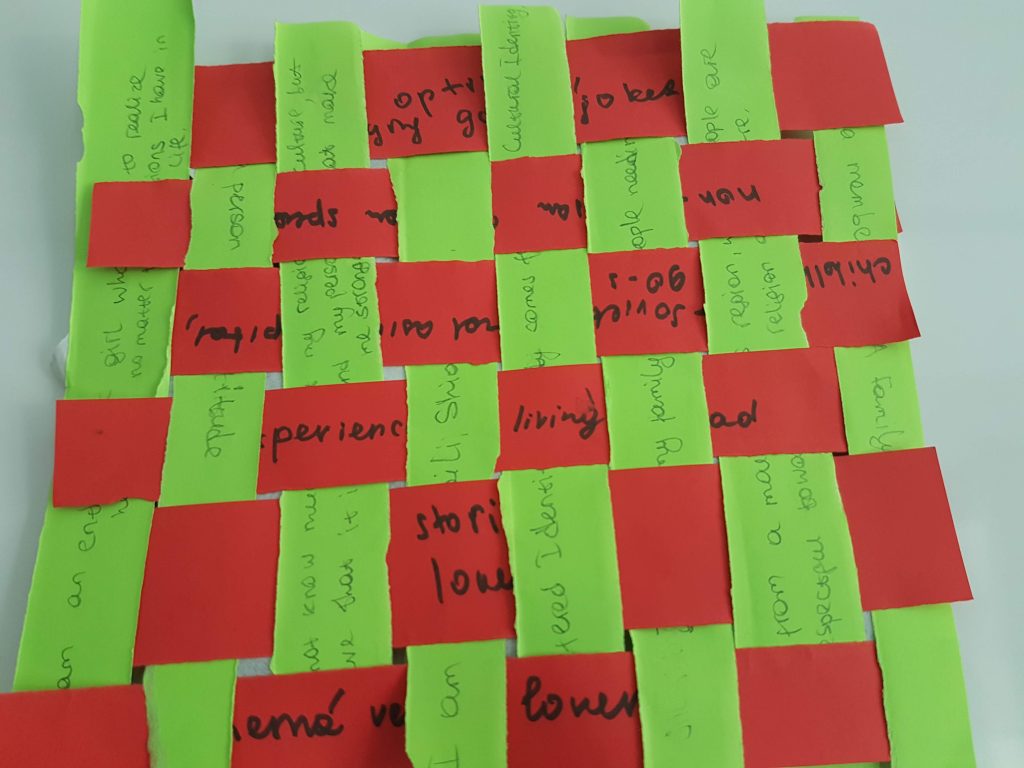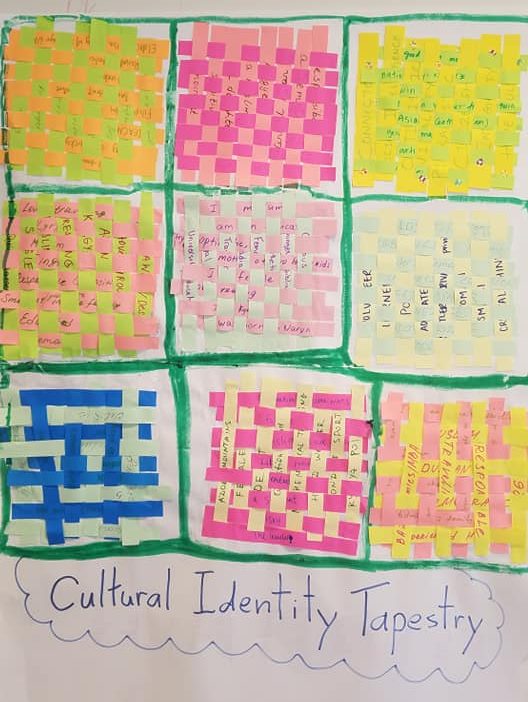9 Weaving Life Identities

Purpose:
This activity helps participants to explore their core identity and values. It also gives them an opportunity to listen to someone else’s narrative about their identity formation. When participants are finished their personal and dyad explorations, the squares presented together provide a visual tapestry that reminds group members of the ways our stories can be woven together as we listen to each other’s experiences.
Learning Objectives
Participants will:
- Reflect on their identity and choose eight different components that are most important to their sense of themselves.
- Practice empathic listening skills when sharing identities with a partner.
- Discuss identities that are public and hidden.
- Examine the concept that people in the majority of a population or in positions of privilege often do not think about their status as part of their valued identity.
- Create a visual tapestry that reflect the identities of the group.
Activity Directions
- Ahead of time prepare paper strips: Facilitator needs a variety of different coloured square papers. One square is needed for each student. Ahead of time, cut the squares into 8 strips and clip each group of 8 strips with a paper clip.
- Group Discussion: Ask students about what they think personal identity means. One way of looking at identity is that it answers the question, “Who am I?” People’s sense of their personal identity may or may not include things like ethnicity, family roles, nationality, age, societal roles, interests, characteristics and strengths. Discuss what aspects of personal identity we are born with and which things we choose. Instructor might need to give a couple examples of aspects of their own identity to help participants reflect.
Examples of valued aspects of personal identity
- “Being an artist is who I am – I feel like I am most myself when I am expressing myself with paint.”
- “Being Canadian is important to my personal identity because it has shaped my connection to nature and my appreciation of a multi-cultural society.”
- “Being a student is an important aspect of who I am because it impacts how I spend my time and what fills my mind. I am the first person in my family to go to college, so I carry the weight of many expectations.”
- “Being bi-racial is important to me because it is the crazy beautiful complexity of where I came from. Being brown in a dominant white society also means that I notice how I am different with the positives and negatives that has entailed.”
- “Being a mother is important to my identity because loving my kids and watching them grow has been the most important part of my life.”
3. Identify 8 aspects of identity: Give each student 8 strips of the same-coloured paper and ask them to write a short sentence on each strip that describes one aspect of their identity. (15 minutes)
4. Dyad Discussion: Ask participants to find a partner and the two people take turns explaining an aspect of their identity from their strips of paper.
5. Weaving paper strips: When they have each shared the dimensions of their identity, the dyad weaves their strips together going over and under with one colour horizontal and the other vertical to form a woven square.
6. Group Tapestry: Tape all squares to the wall or whiteboard to create a tapestry of all the class identities woven together in a patchwork quilt.

GROUP DISCUSSION DEBRIEF
- How did you choose which eight things were most important to your identity?
- What were some of the similarities and differences between you and your partner?
- In your woven square some parts of your identity are public and visible and some are hidden. What are the reasons people sometimes hide parts of their identity?
- Research has shown that people from a majority culture often do not identify that characteristic as a salient part of their identity. This is possibly because they have not needed to advocate for their rights (example: white, heterosexuals do not always identify those facts as being important ways they define themselves, while brown, gay people have had to fight to feel respected and are more likely to value those identifiers). What are your thoughts on this? Was this true in your dyad discussions?
- What did you learn about yourself and others in this activity?
- How is reflection about our personal identities part of emotional intelligence?
- How do we get to know what other people value about their identity?
Optional Follow Up:
Write down insights and reflections from this excercise in a personal reflections journal or on a shared on-line forum discussion on a platform like moodle or padlet.
Online Adaptation:
Weaving the squares is not possible if participants are on-line, but choosing 8 components of your identity and discussing in dyads or break-out rooms is still valuable. A variation on this exercise involves asking participants to write down the eight descriptors of their identity and then contemplate which are the most important. Ask them to look at their list and then cross the three least important aspects off the list. Discuss with the group. Then ask them to cross off another three descriptors of their identity until there are only two items left on their list. Facilitate a discussion on how participants chose what to let go of and what to keep. Why are these two aspects of identity the most important to hold onto? Where did values about what is important in personal identity come from?
This adaptation was introduced by facilitators from the Global Centre for Pluralism.
Resources and Materials:
- multi-coloured papers cut into squares and then cut into 8 strips
- Paper clips for the sets of coloured strips that go to each person
- tape to make tapestry of woven squares
References:
Adapted from: Arredondo, P., Toporek, R., Brown, S., Jones, J., Locke, D., Sanchez, J., & Stadler, H. (1996). Operationalization of multicultural counseling competencies. Journal of Multicultural Counseling and Development.
